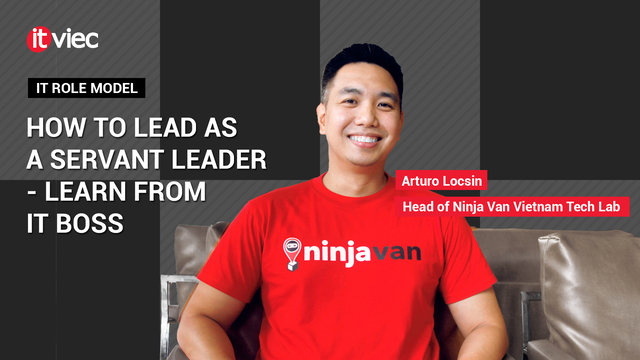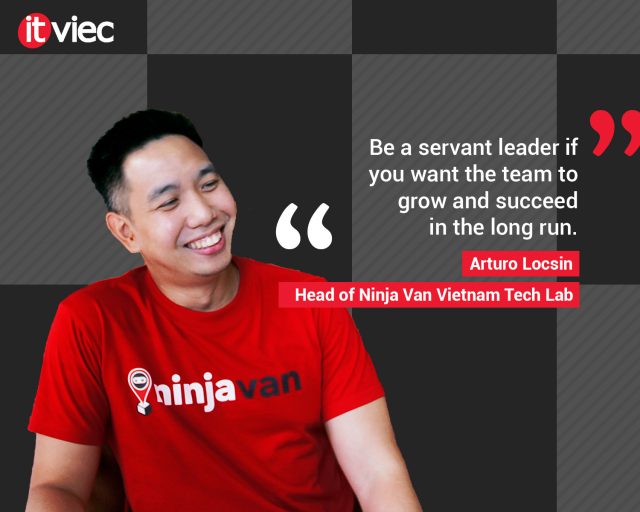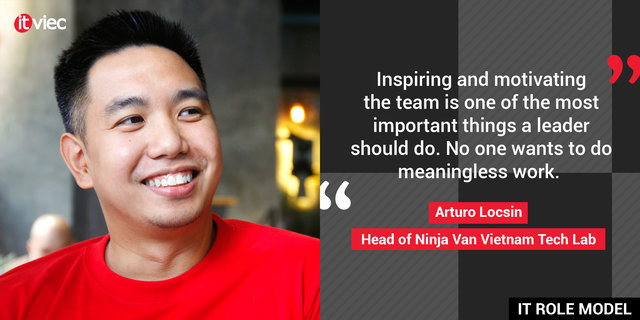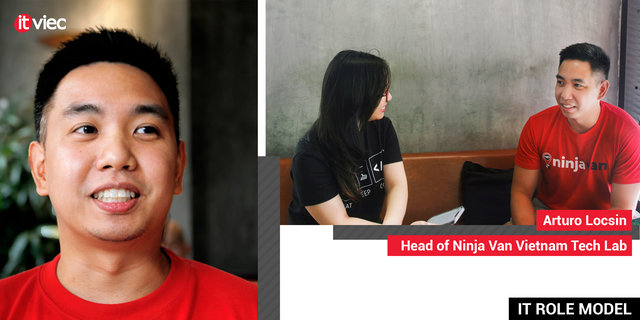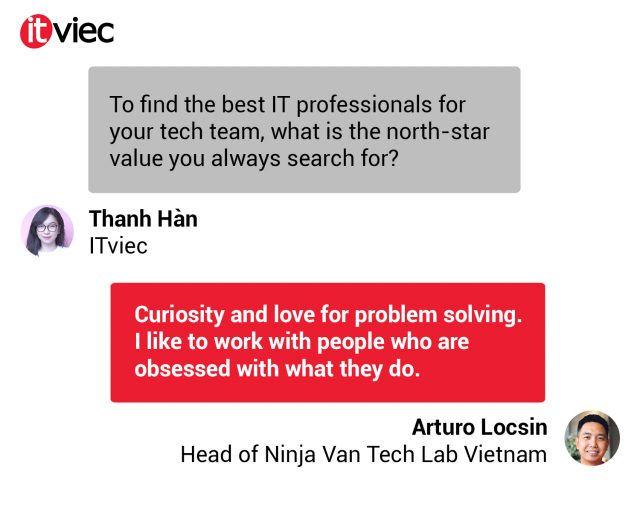Nội dung chính
Read the Vietnamese version here.
The term “servant leadership” was first used by Robert K. Greenleaf in his essay “The Servant as a Leader” written in 1970. But it is a method that has been utilized by humans for generations. How does this method of leadership work in an IT team? Or more specifically, how can an IT leader benefit from adopting this strategy? Perhaps the answer to your questions can be found in this post.
About Arturo Locsin
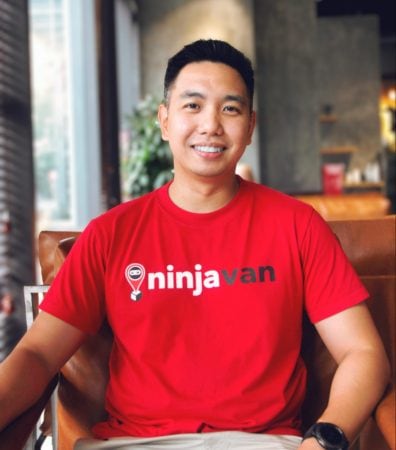
Arturo’s experience may share a lot in common with you, anyone who plays a leadership role, either in product management or engineering management. With a background in Computer Science and Software Engineering, he has taken a career-changing decision to pivot his career into Product Management.
Arturo has been a strong advocate for servant leadership throughout his entire IT career. We had a great conversation with him on this topic, at a coffee shop in district 10, near Ninja Van’s office.
“Be a servant leader if you want the team to grow and succeed in the long run. Instead of just pushing your team to reach company goals, it’s better to understand and align each person’s strengths, personalities, and motivations with the goal, and help them get there.”
Arturo Locsin – Head of Ninja Van Vietnam Tech Lab.
What does “servant leader” mean to an IT boss?
What do you understand by the term “servant leadership”, and how would you portray this leadership style in your work?
Arturo: To me, servant leadership is about empowering your team, not only to do their work, but giving them the right level of support, and, enabling them to own their decisions on how to get their work done. It’s doing everything in your power to make sure your team can succeed by giving them the right tools, providing the right environment, removing impediments, and connecting them with others who can help them. It’s all about elevating your team, not yourself.
I believe leaders who empower and enable their teams help those individuals reach their full potential much more effectively than a manager who constantly commands and prescribes how to do their work, limits their opportunities to learn in-depth, and they won’t feel as responsible for the outcome as they would if they were the ones who owned the process and solution.
When we were setting up our Tech lab in Vietnam, Cheehan Tee (VP of Engineering at Ninja Van) empowered me to make decisions on how to start and run the office. He was also constantly giving me advice and connecting me with others in the organization that could help. I felt great that I can accomplish anything, that I have the power to make any part of my work better, and that the only limiting factor is myself. This made me feel a strong sense of ownership over my job and responsibilities, and in turn, I wanted to do more for the company.
What is your best practice to apply the “servant leadership” style?
Arturo: One style won’t work in all cases, so you have to apply situational leadership. For example, some people might prefer to be instructed precisely instead of being given autonomy. Or some people aren’t really looking to perform at their “full potential” and are okay with settling for “good enough”.
Whatever the case, the common practice I do is to focus on understanding all aspects of the person – understand them better on a personal level, where they are in their career, their personality, their mindset, and even their personal life. I then tailor my approach and deliberately find ways to empower them and transfer more ownership at a pace that suits them.
What would you do when the team doesn’t want to achieve “full potential”?
Arturo: If someone isn’t motivated or fully committed, I always refer back to one of my favorite quotes from Antoine de Saint-Exupéry (author of The Little Prince): “If you wish to build a ship, do not divide the men into teams and send them to the forest to cut wood. Instead, teach them to long for the vast and endless sea.”
Inspiring and motivating the team is one of the most important things a leader should do. No one wants to do meaningless work. So it’s our job as leaders to make sure WHY the work or goal matters is clearly communicated and understood by the team.
Intrinsic motivation factors are always better to motivate people, compared to extrinsic factors like salary, bonus, nice office, and ping-pong tables. Make them realize how their work is impactful to the people who benefit from the product, the community, or even how we are contributing to the world’s digital transformation.
Also, be truly authentic about it. If you don’t believe in something yourself, how can you effectively persuade your team to believe in it as well, right?
How is the servant leadership style compared to other dominant leadership styles?
Arturo: I think where the “dominant” leadership styles differ is in decision-making. A command-and-control style will of course result in faster results as there is less time spent agreeing on a decision. This approach is fine if you want to achieve results fast. However, if you want to have a stable and high-performing team in the longer term, then this approach might not be the best as it will limit the growth and motivation of the people in your team.
In urgent or critical cases, I do have to apply a more “dominant” style as well, as part of situational leadership, but it’s something I’m not comfortable with and I’m careful to make sure it’s only temporary.
The cliche proverb “If you want to go fast, go alone. If you want to go far, go together” really does apply here.
How to become a “servant leader”?
Which role model(s), or mentor encouraged you to become a “servant leader”?
Arturo: To me, a mentor is someone who has expertise and experience, and can teach me in specific areas I need to improve on. A role model is someone I aspire to be like, or who has traits that I want to develop in myself.
I consider Andrew Duck, my boss at Audience Media, as one of my earlier mentors on leadership.
What was the most meaningful lesson you received from your mentor about servant leadership?
Arturo: There was a time when my colleagues and I were supposed to present a solution to stakeholders. We presented the solution to Andrew and received not-so-great feedback. However, there was not enough time to change it anymore, and when we went ahead to present it, he still fully supported and defended our solution 100%, even if it might make him lose face. At that moment, I felt very supported and even more motivated to do even better next time.
Another was when he gathered me and other tech leads because we were failing on something. He said something along the lines of “What are you looking at me for, that’s what I hired you guys to do. I hired intelligent people, so get yourselves together and get it done”. It was supposed to be reprimanded, but it did not feel that way at all to me. I felt that he trusted in our abilities and that he knows we could do better. And that’s exactly what we did.
To improve your leadership qualities, which books or reading materials are your go-to?
Arturo: If I’m looking to learn something specific, Google. I don’t have a single go-to resource, as I research case-by-case. But whatever I find, I do make sure I check dozens of research materials and articles on a single topic and check the credibility of the source.
If I’m passively browsing before I go to bed, then LinkedIn. I do follow a couple of people that I have randomly come across in the past few years: On leadership, I follow Simon Sinek and John C. Maxwell. On technical leadership, I follow Gergely Orosz, and Henry Surawirawan (Tech Lead Journal). On agility, I follow Mike Cohn (Mountain Goat Software) and Maarten Dalmijn.
I also think leaders should be good storytellers, so on storytelling and writing, I follow Nathan Baugh and Chase Dimond. These people regularly post small bits of information that I find valuable. And if there are discussions or debates going on in their posts’ comments section, I make sure to look into them as well, to understand the different perspectives.
For books, I really liked Thinking Fast And Slow by Daniel Kahneman. It really helped me think more critically, challenge everything, and be aware of tricks my own brain may be pulling on me.
My other favorite book is Essentialism: The Disciplined Pursuit of Less by Greg McKeown. Key takeaways are to know what’s important for you and tailor your life to align with those priorities.
That’s an interesting wrap of “servant leadership” and how you demonstrated it throughout your career. Thank you so much, Arturo.
Arturo’s career – From Developer to Product Manager
When it comes to IT career, you also have set a great example with your major expertise pivot. So, why don’t we begin with the first personal question?
What are the three words or phrases that best describe who you are?
First would be obsessive – when there is something I like, enjoy, or find interesting, I never get tired of doing more of that.
And because of not being tired of things that interest me, I get to spend enough time being good at those things. I really believe in the 80/20 or “Pareto” principle, and this has led me to become a “Jack of all trades”. The full and not well-known saying is actually “Jack-of-all-trades, master of none, but oftentimes better than a master of one.”
And lastly, synergistic. I believe that each person has much more depth and capabilities than what we can see on the surface. Knowing enough about multiple trades allows me to understand and recognize opportunities from different perspectives, and match them with people’s potential.
Which road brought you to your IT career?
Arturo: I started getting into computers and the internet in 1996 at internet cafes. I would use Yahoo! Search to find articles, media, and music on my then passion – Animé. I was quite the Otaku back then. In 1998, my uncle bought a home computer, and I got addicted to games like Half-life and Counter-strike, and got into basic scripting and modding.
At the time, we had computer classes in high school that had basic programming projects, which by then I was already familiar with and really enjoyed doing. I enjoyed coding so much that I did multiple versions of the same project and would sell it to classmates to pass as their own. The money I earned from that, of course, I used to play Counter-strike at LAN cafes.
The love for both programming and video games led me to take Computer Science in university, aspiring to be a game developer. My interest shifted more into A.I. in my final year when my thesis group and I implemented a supervised learning algorithm into an open-source Warcraft I engine, which we customized to be like Dota, and make the “creeps” more “intelligent”.
After graduating, I then pursued a job related to A.I. as a desktop application developer working on a credit risk evaluation system for banks. I enjoyed the work there, but I got impatient as the payoff from coding business-facing desktop applications was not as rewarding as consumer-facing applications. So then I started to do both personal and freelance web projects, which I found more intriguing because I could see my work reaching more people.
Why did you decide to pivot your IT career into Product Management?
Arturo: I experienced a solid start-up environment when I was in Audience Media. I was a web developer, but I got to experience much more – I got to do requirements gathering, deployments, customer support, project management, scrum mastering, engineering management, roadmaps, you name it!
Eventually, I was doing more talking to different departments and stakeholders to understand their needs, roadmaps, and taking care of the backlog, and realized that I enjoyed it a lot more than doing the engineering management. So I asked my boss if I could transition into a technical product owner role and he was happy to support me in that.
Inspiring lessons from Arturo Locsin
What circumstances led you to Ninja Van Vietnam Tech Lab?
Arturo: It was purely by chance! I attended a ProductTank HCMC event whose speaker was the Ninja Van’s Head of Product. I got to talk to him after the event and we exchanged ideas and experiences. On his next visit to HCMC a few months later, he invited me to lunch with the rest of his product team and continued to have great conversations.
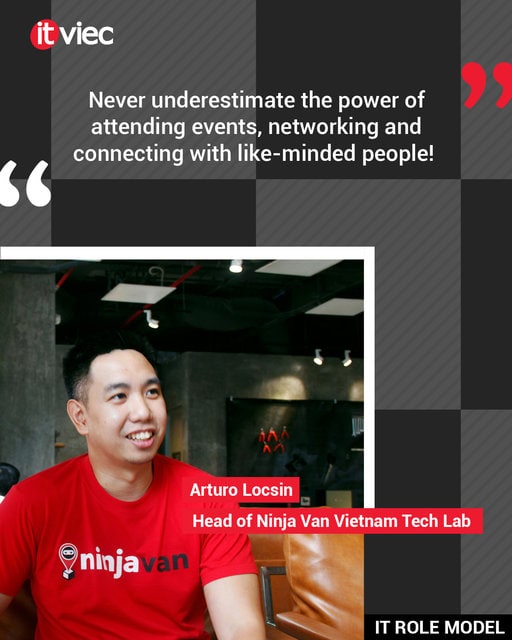
So never underestimate the power of attending events, networking, and connecting with like-minded people!
What are the most significant cultural shocks/cultural events when working with people from diverse backgrounds and nationalities?
Arturo: Working with Vietnamese colleagues didn’t cause much cultural shock since Filipino culture has a lot of similarities. Both have a hierarchical culture and strong respect for seniors or elders. In a multinational organization, you can call your boss by their first name without any honorifics. It was uncomfortable to me at first as I naturally felt like I was being disrespectful, but I’ve come to get the habit of it over time. But it also got me used to a work environment where everybody’s voice matters, and that it’s your actual expertise that counts, not your age or seniority.
Speaking of hiring, to find the best IT professionals for your tech team, what is the north-star value you always search for?
Arturo: Curiosity and love for problem-solving. I like to work with people who are obsessed with what they do. Candidates who are still curious about how to solve problems or follow up on interesting topics we covered even after the interview do catch my attention.
What advice do you have for other IT professionals who want to advance in their careers?
Arturo: Prioritize learning early in your career before compensation. Choose an environment that gives you opportunities to have that give you hands-on experience, no matter the field. Nothing beats getting immersed and hands-on experience.
And don’t settle for mediocre or just “good enough”, especially on your expectations of yourself. You can always do and achieve more.
Thank you, Arturo.
Thank you, ITviec.
Wrap-up
This post, which includes real-life examples from an IT leader, may have given you some food for thought. So, as an IT leader, what kind of leadership style do you apply? Who has influenced or impacted your view of leadership? What kind of leader do you want to be? Feel free to tell us about it.
Explore other jobs from Ninja Van Vietnam Tech Lab here.


